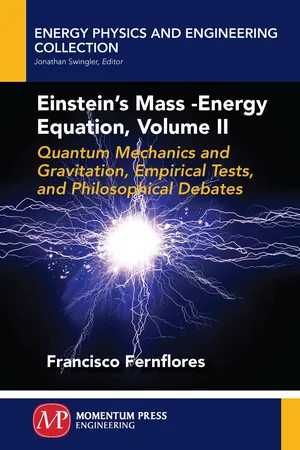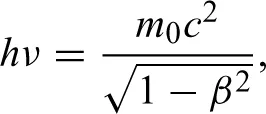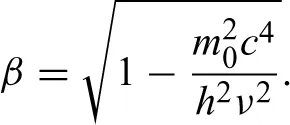
This is a test
- 97 pages
- English
- ePUB (mobile friendly)
- Available on iOS & Android
eBook - ePub
Einstein's Mass-Energy Equation, Volume II
Book details
Book preview
Table of contents
Citations
About This Book
In this second volume, we examine the role that Einstein's mass–energy equation played in the development of two important theories in early twentieth century physics: de Broglie's "matter waves" and general relativity as a theory of gravitation. We also discuss the first empirical confirmation of E = mc2 by Cockcroft and Walton. We investigate the somewhat surprising fact that Cockcroft and Walton's paper reporting their result makes no mention of either Einstein or his famous equation. Finally, we examine some of the contemporary debates concerning how the mass–energy relation should be taught and understood philosophically. We close with some suggestions for future research.
Frequently asked questions
At the moment all of our mobile-responsive ePub books are available to download via the app. Most of our PDFs are also available to download and we're working on making the final remaining ones downloadable now. Learn more here.
Both plans give you full access to the library and all of Perlego’s features. The only differences are the price and subscription period: With the annual plan you’ll save around 30% compared to 12 months on the monthly plan.
We are an online textbook subscription service, where you can get access to an entire online library for less than the price of a single book per month. With over 1 million books across 1000+ topics, we’ve got you covered! Learn more here.
Look out for the read-aloud symbol on your next book to see if you can listen to it. The read-aloud tool reads text aloud for you, highlighting the text as it is being read. You can pause it, speed it up and slow it down. Learn more here.
Yes, you can access Einstein's Mass-Energy Equation, Volume II by Francisco Fernflores in PDF and/or ePUB format, as well as other popular books in Physical Sciences & Physics. We have over one million books available in our catalogue for you to explore.
Information
CHAPTER 1
MASS–ENERGY, WAVE MECHANICS, AND GRAVITATION
Einstein’s mass–energy relation became such an important result in 20th century physics partly because of its unique role in shaping the mostly independent development of the two theoretical cornerstones of modern physics: quantum mechanics and general relativity. In this chapter, we will examine some of the key moments in the developments of these two main branches of physics by investigating first the role that the mass–energy relation played in de Broglie’s hypothesis of “matter waves” and second the role it played in the development of Einstein’s theory of gravitation, i.e., general relativity.
1.1 DE BROGLIE’S MATTER WAVES
In 1929, Louis De Broglie was awarded the Nobel prize in physics “for his discovery of the wave nature of electrons” [1]. Five years earlier, de Broglie had presented his dissertation titled Recherches sur la Théorie des Quanta at Paris University in which he first postulated what later came to be called “matter waves.” That same year, de Broglie’s novel attempt to reconcile the wave-like and particle-like behavior of light, which led to his hypothesis of “phase waves” for all matter including light, was published in English for the first time in a paper titled “A Tentative Theory of Light Quanta” [2].1
There is widespread recognition that de Broglie’s work was deeply influential to Schrödinger in the development of his wave mechanics. Schrödinger himself begins his ground-breaking exposition of wave mechanics for Physical Review in 1926 by saying
The theory which is reported in the following pages is based on the very interesting and fundamental researches of L. de Broglie on what he called “phase-waves” (“ondes de phase”) and thought to be associated with the motion of material points, especially with the motion of an electron or proton. The point of view taken here, which was first published in a series of German papers, is rather that material points consist of, or are nothing but, wave-systems [3, p. 1049].
Historians of physics Raman and Foreman have even asked, in the title of one of their papers, “Why Was It Schrödinger Who Developed de Broglie’s Ideas?” [4]. Yet, a close examination of how de Broglie arrived at his famous and influential hypothesis and especially one that focuses on the role that Einstein’s famous equation E = mc2 played in these developments has yet to appear in the literature (as far as we know). Thus, we begin here with just such an examination by focusing on de Broglie’s 1924 paper “A Tentative Theory of Light Quanta” [2].
1.2 FIRST MOVES: PHOTONS OF FINITE MASS
de Broglie introduces the problem he wants to solve by first stating that there is sufficient evidence to support the “reality” of light quanta (“photons” hereafter). He cites Einstein’s work on black body radiation and his account of the photoelectric effect, Bohr’s work on the structure of the atom, and Compton’s work on X-ray diffraction. Significantly, though he does not draw attention to it, de Broglie focuses on how experiments concerning the behavior of light confirm the hypothesis of light quanta. de Broglie then states that his goal is to reconcile light’s particle-like behavior with its wave-like behavior. He says:
I shall in the present paper assume the real existence of light quanta, and try to see how it would be possible to reconcile with it the strong experimental evidence on which was based the wave theory [2, p. 446].
Notice de Broglie’s careful wording here. The challenge he sets himself is to reconcile experimental evidence that strongly supports the “reality” of light quanta, i.e., that light is quantized, with empirical evidence that supports a competing hypothesis, viz., that light is a wave phenomenon. The challenge seems insurmountable because these two hypotheses had historically been treated as mutually exclusive and exhaustive. Yet, de Broglie’s is suggesting that there may be a single, unified, theoretical description of both the particle-like and wave-like behavior of light.
With the task clearly outlined, de Broglie begins by making the following assumptions:
1. All photons are identical.
2. The only difference among photons is that they have slightly different velocities each of which is very near the speed of light.
3. Each photon has a finite mass m0.
4. Because photons “have velocities very nearly equal to Einstein’s limiting velocity c, they must have extremely small mass (not infinitely small in a mathematical sense)” [2, p. 447].
From our contemporary perspective, the most glaring assumption is that photons have velocities near, but not equal to, the speed of light, and that they must therefore have an extremely small, but finite, mass. Strictly speaking, special relativity does not impose any constraint on the mass of an object that moves uniformly close to the speed of light relative to some inertial frame. However, if an object P moves with a velocity u very near the speed of light relative to an inertial frame K and the mass mK of P relative to K is very small, the rest-mass m of P must be significantly smaller than mK since m = mK/γ(u), where γ(u) is the usual Lorentz factor.
de Broglie now suggests that given the Einstein-Planck expression for the energy of a photon, i.e., E = hν, and given that Einstein’s theory of special relativity entails that the total energy of a particle is given by2

it follows that, for a given photon,

where β = υ/c. Solving for β in Eqn. (1.2), we have:

Finally, using a familiar series expansion for the right-hand side of Eqn. (1.3) and neglecting terms of the second and higher orders, since we are dealing with a case in which υ ≈ c and hence 1 − β2 is “a very small quantity,” we obtain

de Broglie uses this last equation to conclude that “It then seems that m0 should be at most of the order of 10−50 gr.” [2, p. 447]. Somewhat surprisingly, his approximation is within one order of magnitude of some recent experimentally determined upper limits on the mass of a photon such as Luo et al., who find this limit to be 1.2 × 10−51 g [5]. Yet, de Broglie does not explain how he arrives at his approximation and it cannot be merely by substituting empirical values into Eqn. (1.4), for we would need to know at least the approximate velocity of photons. However, when it comes to the velocity of photons, de Broglie says:
The light quanta would have velocities of slight...
Table of contents
- Cover
- Title
- Copyright
- Abstract
- Contents
- Preface
- Acknowledgments
- 1. Mass–Energy, Wave Mechanics, and Gravitation
- 2. First Empirical Test of E = mc2
- 3. Contemporary Debates and Insights
- 4. Philosophical Conclusion and Future Directions
- Bibliography
- Index